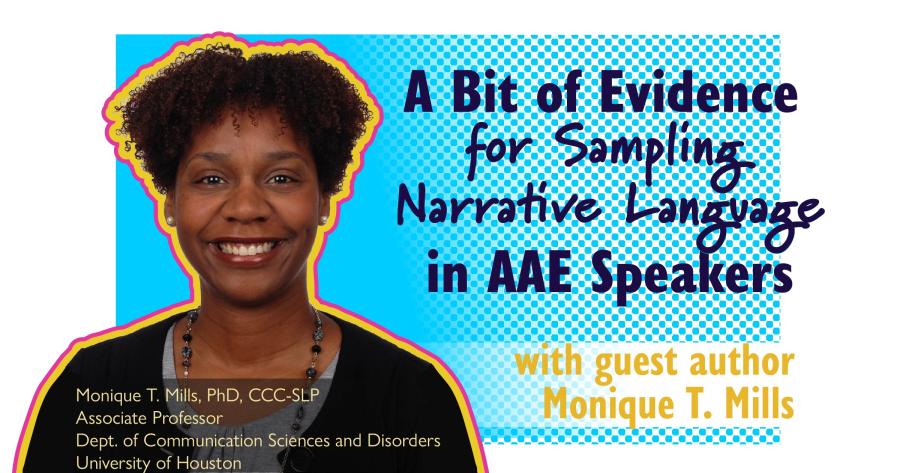
A Bit of Evidence for Sampling Narrative Language in AAE Speakers

A Bit of Evidence for Sampling Narrative Language in AAE Speakers
Published at: 2021-02-02
Dear Clinical Colleagues, I hope this finds you relatively safe and sane. Language sample analysis may be a challenge to your limited time and resources. Don’t you wish you COULD fit language sampling into your busy schedule? After all, language sampling is part of the “gold standard” for assessing language in monolingual and bilingual children. After you collect a language sample, you can analyze it either by hand or with computer software. Best practices are still underway for language sampling in children who speak African American English (also known as African American Language). I want to share with you a bit of evidence for sampling narrative language in AAE speakers based on my 2016 paper published in the American Journal of Speech-Language Pathology. But, before I walk you through the steps, let me give you the take-home message: theory of mind measures do not penalize production of AAE in children’s narrative language. Therefore, INCLUDE THEM in your language assessment protocols. You might be wondering, “What does theory of mind have to do with narrative language?” Glad you asked! Without theory of mind, children would only tell us what happened in the story. A story centered on action is incomplete. Listeners also need to know why those actions were important – what actions really mean to the actors as well as those acted upon. In other words, children need to provide a landscape of consciousness as well as a landscape of action in their narrative language. This way, their audience understands what drives characters in the story to act as they do (see also Bruner, 1986).
- Collect and audio-record a narrative sample elicited from the Frog, Where are You? (FWAY) book. During the covid-19 pandemic, you’ll want to safely use SALT’s online elicitation protocol (see ASHA’s practice portal on telepractice for more info).
- When children retell FWAY, listen for their mentioning the false-belief episode pictured below:

- Apply the rubric found in Mills & Fox (2016) on page 439 (Appendix B)
- Do they mention the episode?
- How well do they recount it?
- Is there no, some, or accurate display of false belief?
- How many clauses do they include in the utterances for this episode?
- After you address narrative language in treatment, repeat this process so that you can monitor progress.
- If you are completing an initial- or re-evaluation, you will also want to administer a norm-referenced test of narration, such as the Test of Narrative Language-2, to complement your narrative sample.
- Report how well your (potential) client stacks up against children reported in the literature on theory of mind and narrative language:
- Children with typical language development (TD)- monolingual (English) and bilingual (Spanish/English): Pearson (2001)
- Children with developmental language disorder (DLD), autism spectrum disorders, and TD: Norbury & Bishop (2003)
- Children with DLD, William’s syndrome, focal brain injury, and TD: Reilly, J., Losh, M., Bellugi, U., & Wulfeck, B. (2004)
- Children with and without cochlear implants: Peters, Remmel, & Richards (2009)
- Children with TD who speak AAE: Mills & Fox (2016)
Thanks for reading my musings on all of this. I continue to be fascinated by how children express their thinking and language skills! Language sampling is a great way to capture it all. __________ Monique T. Mills, PhD, CCC-SLP Associate Professor Dept. of Communication Sciences and Disorders University of Houston Dr. Mills’s research program employs mixed methods to examine the cognitive, social, and linguistic resources that school-age African American children draw upon to narrate, or tell stories. She directs the Child Language Ability Lab, which is currently engaged in projects examining narrative assessment. Dr. Mills teaches her students about language development, language variation, and research methods in communication sciences and disorders. She believes that her utmost vocation, or calling, is to help humans thrive. In addition to her work, Dr. Mills loves being on her couch, cooking, hiking, listening to music, playing with new ideas, reading, spending time with friends and family, and thrift shopping. __________ Last update: 2 Feb. 2021
No Comments yet. Be the first to comment.